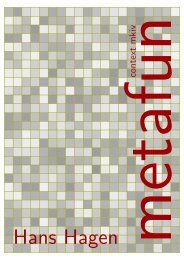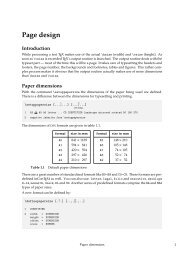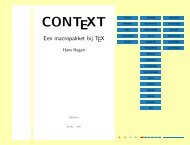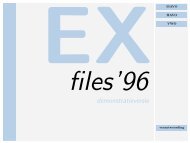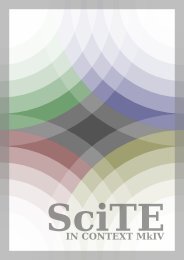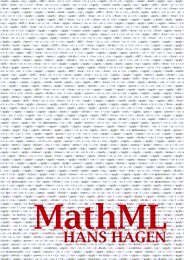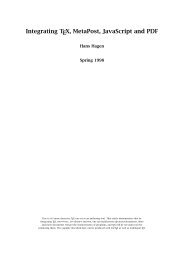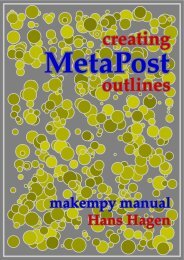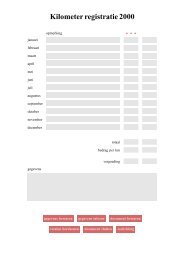Hagen - Pragma ADE
Hagen - Pragma ADE
Hagen - Pragma ADE
You also want an ePaper? Increase the reach of your titles
YUMPU automatically turns print PDFs into web optimized ePapers that Google loves.
14<br />
Font formats<br />
can be rules that turn 1/2 into one glyph, or transfer the numbers into superior and<br />
inferior alternatives, but leaves us with an unacceptable rendered 1/a, given that the<br />
frac features is enabled. It looks like features like this are to be applied to a manually<br />
selected range of characters.<br />
The fact that an OpenType font can contain many features and rules to apply them<br />
makes it possible to typeset scripts like Arabic. And this is where it gets vague. A generic<br />
OpenType sub-engine can do clever things using these rules, but if you read the specification<br />
for some scripts additional intelligence has to be provided by the typesetting<br />
engine.<br />
While users no longer have to care about encodings, map files and back-end issues,<br />
they do have to carry knowledge about the possibilities and limitations of features. Even<br />
worse, he or she needs to be aware that fonts can have bugs. Also, as font vendors have<br />
no tradition of providing updates this is something that we might need to take care of<br />
ourselves by tweaking the engine.<br />
One of the problems with the transition from Type1 to OpenType is that font designers<br />
can take an existing design and start from that basic repertoire of shapes. If such a<br />
design had oldstyle figures only, there is a good chance that this will be the case in the<br />
OpenType variant too. However, such a default interferes with the fact that the onum<br />
feature is one that we explicitly have to enable. This means that writing a generic style<br />
where a font is later plugged in becomes somewhat messy if it assumes that features<br />
need to be turned on.<br />
T E X users expect more control, which means that in practice just an OpenType engine<br />
is not enough, but for the average font the T E X model using the traditional approach<br />
still is quite acceptable. After all, not all users use complex scripts or need advanced<br />
features. And, in practice most readers don’t notice the difference anyway.<br />
1.7 Lua<br />
A.7 As mentioned support for virtual fonts is built into LuaT E X and loading the so called vf<br />
files happens when needed. However, that concerns traditional fonts that we already<br />
covered. In ConT E Xt we do use the virtual font mechanism for creating missing glyphs<br />
out of existing ones or add fallbacks when this is not possible. But this is not related to<br />
some kind of font format.<br />
In 2010 and 2011 the first public OpenType math fonts showed up that replace their<br />
Type1 originals. In ConT E Xt we already went forward and created virtual Unicode fonts<br />
out of traditional fonts. Of course eventually the defaults will change to the OpenType<br />
alternatives. The specification for such a virtual font is given in Lua tables and therefore<br />
you can consider Lua to be a font format as well. In ConT E Xt such fonts can be defined<br />
in so called goodies files. As we use these files for much more tuning, we come back to<br />
that in a later chapter. In a virtual font you can mix real Type1 fonts and real OpenType<br />
fonts using whatever metrics suit best.<br />
An extreme example is the virtual Unicode Punk font. This font is defined in the<br />
METAPOST language (derived from Don Knuths METAFONT sources) where each glyph is<br />
one graphic. Normally we get PostScript, but in LuaT E X we can also get output in a



